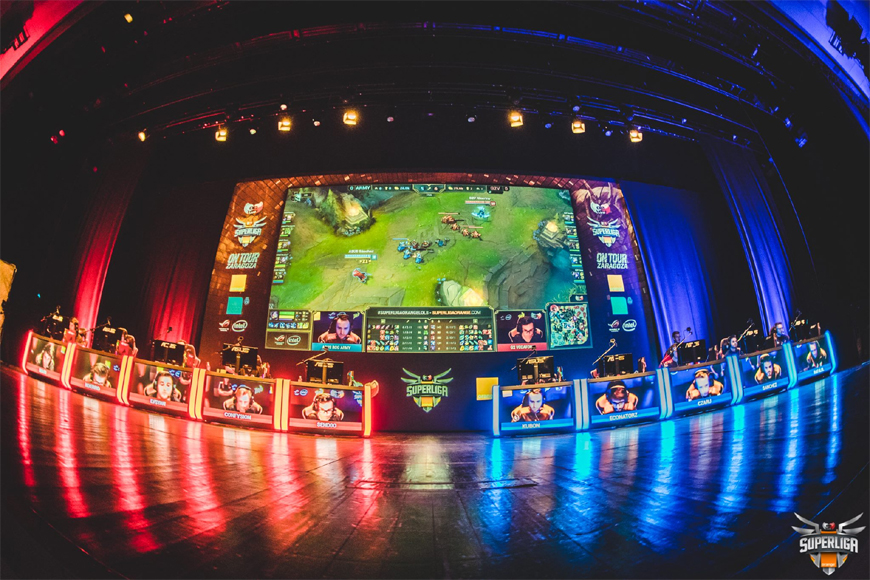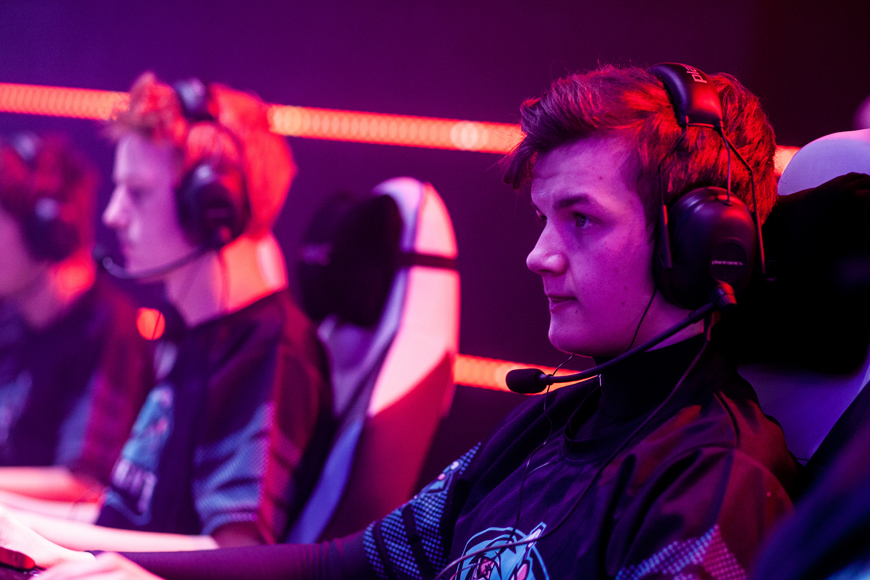The League of Legends scene in Spain has attracted some of the UK’s best players over the past year, who have left our shores for the SuperLiga Orange LVP.
This league has more viewers, more money and greater investment across its two divisions than the UK scene, with the likes of Valencia, ASUS, G2 Vodafone and other big names getting involved. Spain is also home to one of the most well-known LoL pro mid-laners: Enrique “xPeke” Cedeño Martínez.
So why is Spain such a success and what lessons can we learn from our Spanish compadres? Dominic Sacco asks coaches and players…
Why have some UK scene players moved to Spain?
Players like Toaster, Phurion, Yoppa, Special and XDSmiley have left the UK League of Legends scene in the past to move into gaming houses in Spain.
British coaches like Alex “Kazehaya” Hirst and Josh “Furndog” Furneaux have also moved there. Why?
Furndog, G2 Vodafone’s head coach, tells Esports News UK: “The main reason I think that the top UK talent has been attracted by the Spanish scene is the mass infrastructure that has been built in Spain.
“The promise of gaming houses, a full time salary and backroom staff takes promising talent a huge step towards their dreams of becoming professional players.
“The huge viewership of the scene also provides exposure and recognition of that talent, giving you a much higher chance of making it to CS/LCS etc.

Pau “Pochipoom” Prada, coach for KIYF e-Sports Club, comments: “The Spanish scene is far more evolved than the UK when it comes to the League of Legends community.
“There is no doubt that the UK is growing and progressing at a quicker rate than in previous years. I believe we will see it closely follow in our footsteps as it builds up a reputation as an established league.
“Superliga Orange is by far the best league in Spain. It attracts the best players in the region and as a result, coaches are increasingly coming to Spain to develop teams, that are then often scouted by teams playing in the bigger leagues across Europe and the US.”
Pau also agrees with Furndog that strong viewer numbers have also attracted promising European players to Spain.
“We have an established base of spectators helping to make Spain a leading player in the European region of esports, alongside countries such as Germany,” he adds.
How many people watch the LVP?
Sergi Mesonero, co-founder of the LVP, tells Esports News UK: “In 2016 we had over 3.5 million cumulative uniques in our national competition – including our national finals and La Copa.
“If we isolate the finals, our June LoL finals at Gamergy had over 175,000 uniques and our December finals over 264,000 uniques.
“Our average uniques per streaming (only regular season, excluding finals, La Copa and other special streamings) was 44,832 and the time watched over 34,700 hours per program.
“In 2017 we are growing quite a lot. Our current average uniques per streaming is 63,753 and the time watched over 60,000 hours.
“Gamergy attendance is over 30,000 in our three previous editions.”
Those figures are for League of Legends – so what about Call of Duty?
Sergi explains: “Our average uniques per streaming – excluding finals and other special streamings – was 14,061 and the time watched over 3,000 hours per program.
“Our June CoD finals at Gamergy had slightly under 40,000 uniques and December just under 50,000 uniques.
“In 2017 we are also growing a lot with CoD. Our current average uniques per streaming is 17,783 and the time watched over 8,200 hours.”
“Superliga Orange is by far the best league in Spain. It attracts the best players in the region”
Furndog explains: “The SuperLiga Orange is streamed over two days each week.
“The second division doesn’t have an official stream, however some teams like Movistar Riders have their own channel where they stream their games.
“This is a big incentive for the teams to get into the first league so that they gain much more exposure.”
Comparatively, in the UK scene, matches are usually watched in the hundreds or in the low thousands, with record matches running into the tens of thousands, but those are usually one-offs.
How does the prizing system work?
Another incentive for players is of course getting paid. In the UK, amateur tournaments typically have prize pools in the thousands. Anything from around £5,000 at Insomnia (or less) to around £10,000 in the ESL Prem or as much as £20,000 in last year’s UK Masters.
Teams earn a small bonus per win in the ESL Prem, with the overall top two teams taking the brunt of the prize pool.
In Spain, it’s done a little differently.
Furndog explains: “The prizing system for SuperLiga Orange is very different to the UK. The clubs get a prize based on win/draw/loss, they also get a separate prize based on how they do at the Gamergy finals.
“And clubs also get money based on social media interaction. Hence all clubs have social media managers.
“Apparently this year the teams’ prize pool is made up of part viewership of your games in the league, part league position and part social media interaction.”
Grassroots growth
How important are national leagues like the LVP to the whole League of Legends ecosystem?
“This level of the game is very important to the future of our industry,” Pochipoom says. “We need fresh blood to come into the industry and push players to the best of their abilities – as a result salaries improve, competition gets tougher and it’s a more exciting sport for spectators.
“This amateur level of the game is very important to the future of our industry”
“We continually need to look at evolving our industry. Video analysis tools are becoming increasingly important to professionalize the industry and give amateur players the tools they need to build their way up the ranks.
“RiftAnalyst is a great example of a software tool that enables coaches to save time running through match analysis, sitting down with the team to run through key match points. By delivering in-depth analysis quickly, coaches and players alike can continue to evolve the league and push it to more spectators than ever before.”
What can UK LoL learn from Spain?
“I think there needs to be stronger or closer-knit links between the orgs and the league, like ESL, so that they both promote each other,” Furndog suggests.
“In Spain, orgs have to provide Twitter reports regarding their promotion of the league etc. I also feel the league should be more firm with their rulings. If a player chooses to leave a team in Spain – unless it’s to play at a higher level like CS or LCS – that player is banned from competing in the Spanish scene for six months. This keeps teams together much more.
“A big contributor to the Spanish scene’s development is Mediapro buying the rights to the league. And as they work with Spanish football league La Liga, they have transferred lots of their rulings and money to SuperLiga Orange, and have turned it into a more conventional, professional sports league.
“Perhaps the FA or Premier league in the UK could one day do something similar to grow the level of the League of Legends scene.”
Pochipoom says: “The UK has great potential for growth, but it needs time to mature. In Spain, the sector already has an established, defined structure with investment from mainstream brands such as Orange. The company supports the La Liga de Videojuegos Profesional (LVP) and sponsors the Súper Liga Orange tournaments.
“Brands such as Takis, Domino’s Pizza and El Corte Inglés have also invested in esports, resulting in more substantial tournament prizes, greater promotion for professional clubs and high quality match play.”
“The UK has great potential for growth, but it needs time to mature. In Spain, the sector already has an established, defined structure with investment from mainstream brands such as Orange.”
Pochipoom also thinks broadcasters are key to development.
“The UK market won’t be far behind as companies like Ginx have launched the first ever 24-hour UK esports channel,” he adds.
“This will undoubtedly encourage more investment as sponsors look to capitalise on improved viewing figures. This will inevitably lead to the attraction of higher quality players, coaches and presenters to put the UK on the map as a real contender in the esports world.”
Caster hype
Another aspect of the Spanish scene that sets it apart is its casters.
While the UK has some fantastic casting talent, our well-spoken, warm and witty style is in stark contrast to Spain’s super-excited, louder and faster take on LoL commentary.
Casters like Ibai “Ibai” Llanos (above) are more akin to Spanish football commentators than typical esports casters. They’re a key part of what makes the LVP so unique.
Alex “Kazehaya” Hirst, coach from Ragnarok League of Legends 2017 winners Polite and Mature (who previously played in the Spanish scene as PaM), says: “Spain has Ibai, that crazy Spanish guy shouting his head off.
“I don’t understand Spanish but I’d rather watch him cast a tournament in Spanish compared to something like the Challenger Series in English. He’s just really good at what he does and it makes the Spanish league even better.”
“Spain has Ibai, that crazy Spanish guy shouting his head off. I don’t understand Spanish but I’d rather watch him cast a tournament in Spanish compared to something like the Challenger Series in English”
Pochipoom states: “The Spanish National League is made up of a great community of experienced players, coaches and presenters.
“The production of the league is of a great quality, leading to an increased level of good casters, which make the league far more entertaining from a spectator point of view.
“We have an established base of spectators helping to make Spain a leading player in the European region of esports, alongside countries such as Germany.”
Why are there so many gaming houses in Spain?
It’s great that the UK’s MnM Gaming are bootcamping in a gaming house in Leicester right now, but this is temporary.
Many of the Spanish teams have their own more permanent gaming houses. Why?
“So there are lots of events regarding the league and sponsors, both the league’s sponsors and individual org/club sponsors which require player involvement and promoting merchandise etc,” Furndog says.
“The first game of every half split is played on stage, so players need to attend of course, and also the Spanish league does no longer require three Spanish nationals. It requires three of the team to live in Spain, so effectively you can have a full imported team. But because you live in a gaming house in Spain you can compete in the Spanish league.”
‘The UK needs more development’ – Ragnarok winner
https://youtu.be/WszgTPP2rQs?t=35m17s
Kazehaya says: “There’s a lot of big teams in the Spanish and German leagues.
“The UK scene struggles to scrim with the bigger teams from other regions. Because MnM probably has the best possible players on their UK team, they will probably have higher egos because there’s not many teams they’ll play against who will beat them – until CS qualifiers at least.
“I just feel the UK scene needs more development compared to other regions. Other regions are getting more organisations and sponsors investing into the league.
“I just feel the UK scene needs more development compared to other regions. Other regions are getting more organisations and sponsors investing into the league.”
“Spain is now sponsored by Orange, the phone company. If you look at first division Spain, you have G2 Vodafone, Giants’ second team, Origen’s Spanish team, Valencia… their financial backing is so much higher than the organisations of the UK.
“Once the UK starts getting companies investing into it, it will grow and attract more attention. And the quality of play should improve too. If the UK doesn’t get more investment, it will really struggle more in the CS qualifiers.”
THE PLAYERS’ PERSPECTIVE
We ask two players who have played at the top level of the UK League of Legends scene for their views.
First up, Luke “Phurion” Brammer (right), the former ManaLight/MnM Gaming jungler who now plays for Baskonia in the Spanish league, says the fact it’s one of the biggest national leagues is a strong selling point.
“There’s more exposure and money,” he says. “There isn’t a prize pool – they pay out a fixed amount to each team depending on where they place at the end of the season.”
Emil “Larssen” Larsson (left), mid-laner for MnM, has been made several offers in the past, but says he sticks to the UK scene to focus on his studies.
“THE SPANISH SCENE IS 1,000 TIMES BETTER THAN THE UK SCENE”
“I could have already been at a lot higher level in League of Legends, but I said no to all [offers] because it’s not my dream.
“I had some EU CS tryouts but I deny all, because I won’t quit school for the Spanish scene or CS – that’s why I play UK.
“The problem with the Spanish scene is 80% of teams have gaming houses, but if you take that away then the Spanish scene is 1,000 times better [than the UK scene].
“After I’ve done my studies I would likely go hard on League if it’s still a good game, and I’m not ruling it out if the offer is really good.”
Spanish League of Legends veteran xPeke also spoke to us about his thoughts on UK League of Legends during Worlds 2015:
https://youtu.be/b6gWwUwb5x8?t=3m4s
So, Spain is a hot territory in European League of Legends, and the UK clearly has a lot of catching up and learning to do.
You can watch LVP matches on Twitch here
Image credit: Superliga Orange / Kirill_Photos
Top Gambling & Casino Guides
Explore some of our most popular casino, betting, and gaming guides, trusted by UK players this year.
- Top Online Casinos UK 2025
- Best Bitcoin Casinos in 2025
- UK Sports Betting Sites
- No ID Verification Casino Sites
- Non Gamstop Casinos UK

Dom is an award-winning writer and finalist of the Esports Journalist of the Year 2023 award. He has almost two decades of experience in journalism, and left Esports News UK in June 2025.
As a long-time gamer having first picked up the NES controller in the late ’80s, he has written for a range of publications including GamesTM, Nintendo Official Magazine, industry publication MCV and others. He also previously worked as head of content for the British Esports Federation.




